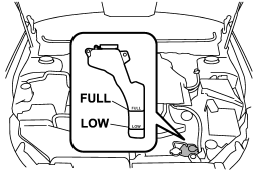Checking the coolant level

Check the coolant level at each fuel stop.
1. Check the coolant level on the outside of the reservoir while the engine is cool.
2. If the level is close to or lower than the “LOW” level mark, add coolant up to the “FULL” level mark. If the reserve tank is empty, remove the radiator cap and refill as required.
3. After refilling the reserve tank and the radiator, reinstall the caps and check that the rubber gaskets inside the radiator cap are in the proper position.
Check the coolant level at each fuel stop.
1. Check the coolant level on the outside of the reservoir while the engine is cool.
2. If the level is close to or lower than the “LOW” level mark, add coolant up to the “FULL” level mark. If the reserve tank is empty, remove the radiator cap and refill as required.
3. After refilling the reserve tank and the radiator, reinstall the caps and check that the rubber gaskets inside the radiator cap are in the proper position.
CAUTION
● Be careful not to spill engine coolant when adding it. If coolant touches the exhaust pipe, it may cause a bad smell, smoke, and/or a fire. If engine coolant gets on the exhaust pipe, be sure to wipe it off.
● Do not splash the engine coolant over painted parts. The alcohol contained in the engine coolant may damage the paint surface.
See also:
Automatic release function by accelerator pedal
The electronic parking brake system has an automatic release function. The parking
brake will be automatically released by depressing the accelerator pedal. However,
the automatic release function ...
Clutch pedal (MT models)
Check the clutch pedal free play and reserve distance according to the maintenance
schedule in the “Warranty and Maintenance Booklet”. ...
How to use the rear view camera
When the shift lever or select lever is set to “R”, the rear view camera automatically
displays the rear view image from the vehicle. When the lever is set to other positions,
the image before set ...


